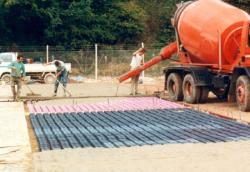Plastic Grass Paving Systems
 It's a growing concern to us that we are being increasingly approached by clients looking to replace failed areas of grassed cellular plastic pavers with our concrete GRASSCRETE system. We should we suppose, be happy to receive the business but instead we are more concerned at the damage this can do to the reputation of grass paving generally, as we realise that not all disgruntled specifiers find their way to us. In some cases failing installations have been in place for only a matter of months. In most instances failure stems from either an inability to accept load or an issue of waterlogging with in some cases both problems being evident. What is a particular concern is that the client may have been advised that plastic systems were suited to their project needs, with some impressive load bearing tests being cited as evidence.
It's a growing concern to us that we are being increasingly approached by clients looking to replace failed areas of grassed cellular plastic pavers with our concrete GRASSCRETE system. We should we suppose, be happy to receive the business but instead we are more concerned at the damage this can do to the reputation of grass paving generally, as we realise that not all disgruntled specifiers find their way to us. In some cases failing installations have been in place for only a matter of months. In most instances failure stems from either an inability to accept load or an issue of waterlogging with in some cases both problems being evident. What is a particular concern is that the client may have been advised that plastic systems were suited to their project needs, with some impressive load bearing tests being cited as evidence.
It's our own firmly held view that laboratory tests can in no way replicate on-site usage and that further questions should be asked of a potential supplier at the enquiry stage to determine actual suitability. As part of our own commitment to "Fit for Purpose" we don't recommend the use of plastic pavers including our own Grassroad system in regularly trafficked applications. A relatively thin layer plastic paver / grass matrix cannot be expected to provide the same sustainable load bearing capability as a reinforced concrete surface.
Also worrying is the trend towards specification of plastic pavers with gravel infill for traffic use. With no grass to provide tensile anchorage, vibration across the surface will naturally cause a sieving effect that can lead to loss of gravel through into the base below. Under traffic use the gravel can also rotate with an abrasive affect on the side walls of the plastic grids, in each case the likely outcome is a break up of the structure.